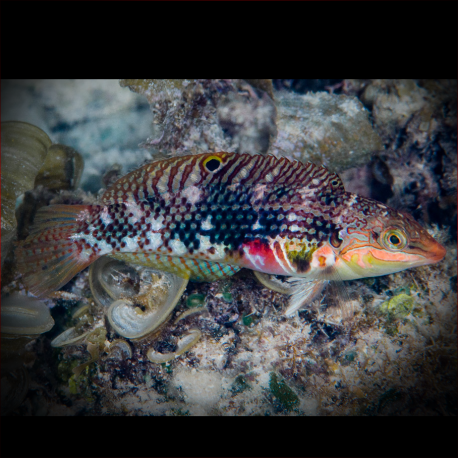More info
Datasheet
| Minimum Tank Size | 340 litres / 89.82 US gallons |
| Maximum Size | 12.7cm / 5.00inches |
| Reef Compatible | Yes |
| Temperament | Peaceful |
| Care Description | Moderate |
| Specific Gravity | 1.020-1.025 |
| Carbonate Hardness | 8-12 |
| pH | 8.1-8.4 |
General Description
The Pearly Wrasse, scientifically known as Halichoeres margaritaceus, displays an appealing sage green body color adorned with pink irregular scribbles, enabling it to camouflage effectively in weedy or algae-covered reef environments, especially where there is strong water movement. Notably, the juvenile and female stages of this wrasse exhibit almost identical appearances.
Aquarium Suitability
Considered suitable for aquariums, the Pearly Wrasse thrives in setups of 90 gallons or larger, alongside peaceful tank mates. It is vital to provide an open space with fine, sandy substrate and at least 2-3 inches depth to allow the wrasse to burrow and find refuge if needed. A secure lid is advisable due to its potential for leaping.
Care and Hardiness
With moderate care requirements, this Carnivore species demonstrates a peaceful temperament. Maintaining stable water conditions with a pH of 8.1-8.4, a specific gravity of 1.020-1.025, and a carbonate hardness (KH) of 8-12 will contribute to its overall well-being in the aquarium.
Reef Suitability
Being reef-compatible, the Pearly Wrasse poses no threat to corals and clams. It actively preys on fireworms and pyramidellid snails, contributing positively to reef health. However, caution is advised with smaller ornamental shrimp and crabs in the tank.
Aquarium Setup
A well-established aquarium comprising ample swimming space, live rock for exploration, and hiding spots is ideal for the Pearly Wrasse. Ensuring proper substrate depth, a secure lid, and a peaceful tank community are crucial aspects of its aquarium setup.
Behaviour
This wrasse species exhibits peaceful behavior towards tank mates but may consume smaller ornamental shrimp, crabs, and various invertebrates. Regularly engaging in burrowing activities, the Pearly Wrasse showcases natural foraging behaviors within the aquarium environment.
Feeding and Diet
Primarily a carnivorous feeder, the diet of the Pearly Wrasse should consist of vitamin-enriched frozen mysis shrimp, brine shrimp, marine flakes, marine pellets, and other meaty foods. Its ability to consume parasites off tank mates when young adds to its value in maintaining a healthy tank ecosystem.
Dimorphism and Captive Reproduction
The Pearly Wrasse exhibits minimal sexual dimorphism, with males often being larger and more intensely colored than females. While captive reproduction of this species in home aquariums is challenging, it has been achieved in select advanced marine breeding facilities.
Habitat and Distribution
In the wild, the Pearly Wrasse is commonly found in regions with weedy or algae-covered reef surfaces, particularly in areas with strong water surge. Its natural habitat includes coral reefs and rocky shorelines across suitable tropical marine environments.

